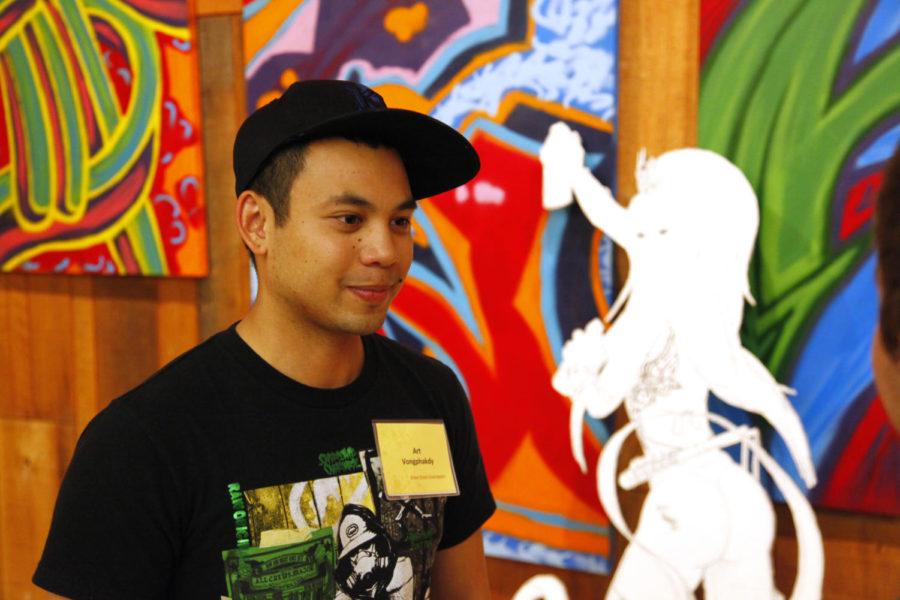Annual research symposium showcases undergraduate student work
Photo: Clark Colby/Iowa State Daily
Art Vongphakdy, junior in integrated studio arts talks about his artwork. He is a graffiti artist. His work represents the final product the graffiti but also the people that make graffiti. So his work gains a three dimensionality and depth through his characters the graffiti artist, the recorder and the wheat paster.
April 19, 2011
Projects ranging from battery comparisons to graffiti art to a scientific look at silver maples and maple syrup were on display Tuesday in the Memorial Union.
Iowa State’s fifth annual Undergraduate Research Symposium hosted 102 students giving 87 presentations on research projects which they have been working on throughout the year.
The program aims to both bolster and showcase the research being done by undergraduates on the ISU campus.
“This is part of the university’s effort to bolster students’ participation in research as undergraduates,” said Dana Schumacher, program coordinator for the University Honors Program.
“Presenting research is part of this continuum of doing research — of bringing this in and taking what it is you know, what it is you discovered, and making it public,” she said.
The format of the event was very similar to research conferences, said Samantha Santeiu, senior in meteorology.
“There’s multiple things going on at once and you can go and see what talks you’re interested in,” Santeiu said.
The undergraduate researchers presented their projects to an audience consisting of a combination of students, faculty and others. A question and answer session followed the presentations.
Jordan Barr, sophomore in chemical engineering, was one of the presenters.
“The title of my presentation was ‘Predicting the Electrical Arc Effects of Ceramics for Electrical Refrigeration,'” Barr said. “I’m just studying an alternative source of refrigeration methods.”
That simplification of the research for the layman is exactly the point of the symposium.
“A part of doing research is being able to talk about what you’ve done to different audiences,” Schumacher said. “[I tell students], you go home for Thanksgiving, tell your grandmother what you’re doing in that lab. How do you do that to people within your discipline? How do you do that to a broader audience? You have to be able to talk about what you did, what you’re looking for, what you found and what difference that makes.”
The symposium was not limited to students in the sciences. Also included were creative writing projects and students from the College of Design working under the FOCUS grant, an effort to fund creative projects in the visual and performing arts by ISU students.
Art Vongphakdy, junior in integrated studio arts, is a graffiti artist. His pieces showcased a progression from, relatively, simple street art designs to a more complex design over a series of four pieces.
“FOCUS … it’s a way to create art that’s not involved with school,” Vongphakdy said. “You can finally do your own thing for once instead of having project guidelines. There’s freedom of expression and they just give you money to create your vision.”
Also on display was a triptych, or a single work contained on three separate canvases, painted by Etienne Blanc, senior in integrated studio arts. His pieces represent a social theory describing the typologies of power as written by Max Weber, a prominent social theorist.
Blanc said he tries to come to the symposium every year, although not always with a project.
“It’s really just to see what’s happening,” Blanc said. “There’s very high quality work. It’s interesting to see the whole range of things that have been done with the grants.”
The event has seen significant growth during its five years. The first year, only 35 students participated. This year the number has grown to 102, ranging in classifications from freshmen to graduating seniors.
“Last year we had three sessions in five rooms,” Schumacher said. “This year we have four sessions in six rooms. So it grew that much.”
Although the Honors program coordinates the event, it’s “not at all limited to honors students,” Schumacher said.
The symposium has been steadily expanding, rapidly gaining students in both the social sciences and creative arts. However, they are still in the minority.
“The hard sciences and engineering, because of the nature of those disciplines, will have more participation,” Schumacher said. “Research is a natural component of those programs.”
The program is all about getting experience for students.
“It’s definitely a good experience to have and it presents options to think about your future,” Barr said. “Whether you want to go into industry right away or go to grad school.”
“It’s a wonderful way for students to get experience, and a wonderful opportunity for people to see the things that happen at the university,” Schumacher said.
The FOCUS grant art exhibits will be on display through the month of April.

















